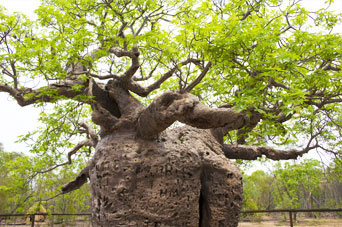Among the world’s most unusual trees, the baobabs are frequently described as being grotesque because of their huge, swollen, bottle-shaped trunks supporting a shallow crown of ungainly branches.
Standing tall on the sunburned plains of Africa and Australia, baobabs may be amongst the oldest life forms on the planet. Many of the specimens standing today have been around for well over two thousand years. Tremendous in size and bizarre in appearance, they have provided food, medicine, and places of refuge and worship to countless peoples, even on occasion serving as prisons and tombs. Long before European explorers opened up the African continent, the news of these “gnarled upside-down giants” had astonished the world of science and stoked the imagination of naturalists.
There are about twelve species of baobabs, of which only one occurs in Australia. Others are found in the hot, dry, savanna country of Africa. The Australian baobab occurs predominantly in the monsoonal north west of the continent. They are scattered in their tens of thousands over large tracts of the Australian outback. Their bare limbed trees are a distinctive feature of the Kimberley landscape.
Baobabs are deciduous, losing their leaves at the beginning of the ‘dry’ winter season when their large, hairy, gourd like fruit is displayed conspicuously against the usually blue sky. Each fruit contains many kidney shaped dark brown or black seeds embedded in a pleasant tasting white pulp that was eaten by Aboriginal people and has given rise to several common names including Cream-of-Tartar Tree.
In Australia, at its best, the baobab reaches fourteen metres in height, sometimes with a trunk girth up to twenty metres. The trunk is often hollow, the spongy wood acting as a storage reservoir for water. These extraordinary trees have always been central to the life of Aboriginal people. The squat, bulbous baobab has provided water, food, medicine, shelter, even burial crypts for Aboriginals, some of whom regard the tree as sacred.

The Prison Tree, near Derby in Western Australia is a famous, or perhaps infamous baobab, reputed to have been used as an overnight cell for Aboriginal prisoners.
The Prison Tree, near Derby in Western Australia is a famous or perhaps infamous baobab, with an enormous hollowed trunk reputed to have been used as an overnight cell for chained up Aboriginal prisoners on their way to Derby for sentencing.
Another alleged prison baobab tree of similar age and size is located near Wyndham at the eastern end of the Kimberley. The remarkable Wyndham baobab has a circumference of 14.7 metres and is estimated to be at least 1500 years old. Like the Derby tree it was said to have been used by local police as an overnight lock up. The Wyndham prison baobab is of cultural significance to the local Aboriginals.
